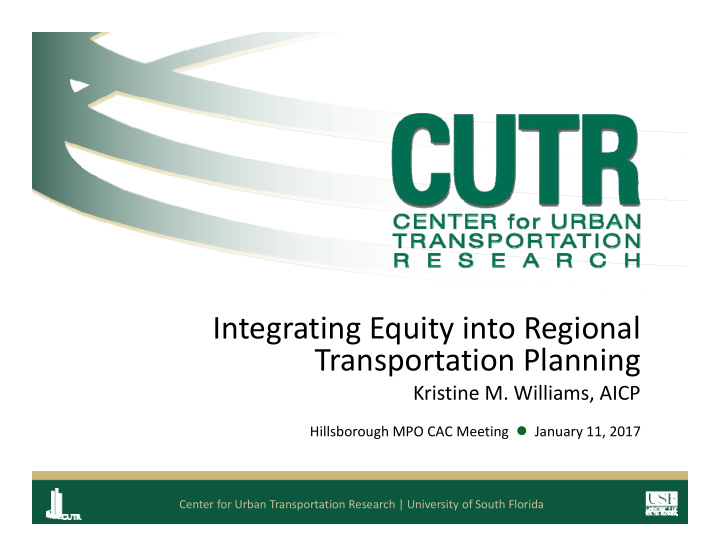



Integrating Equity into Regional Transportation Planning Kristine M. Williams, AICP Hillsborough MPO CAC Meeting January 11, 2017 Center for Urban Transportation Research | University of South Florida
Project Objectives Identify best practices for evaluating equity in regional transportation planning Develop methodology to address key transportation equity issues in plan and project screening Source: mosesmi.org/issues/transprotationequity Apply methods in two diverse metropolitan areas: Tampa and Portland Prepare equity analysis resource guide for MPOs Source: www.youtube.com/watch?v=VjDtZ6uaIjk 2
I m portance of Equity in Planning Ensure equal access to affordable and reliable transportation Ensure certain groups don’t accrue Source: http://www.theatlantic.com/business/archive/2015/05/stranded‐how‐ americas‐failing‐public‐transportation‐increases‐inequality/393419/ disproportionate benefits or burdens 3
Transportation Equity Requirem ents Civil Rights Act of 1964 • Title VI Executive Order 12898 • Federal Actions to Address Environmental Justice in Residents in Dayton, Ohio march along highway to protest lack of bus service to area malls (June, 2013). Minority Populations and Source: Low-Income Populations http://www.slate.com/articles/news_and_politics/politics/2015/02/america_s_transportation_ system_discriminates_against_minorities_and_poor.html 4
Dim ensions of Equity Health and Affordability Safety Distributional Accessibility Equity 5
Portland METRO CASE STUDY 6
Background • Metro adopted outcomes‐ based approach in 2010 with set of performance targets. Two equity related: • Affordability . By 2040, reduce the average household combined cost of housing and transportation by 25 percent compared to 2010. • Access to Daily Needs . By 2040, increase by 50 percent the number of essential destinations accessible within 30 minutes by bicycling and public transit for low‐income, minority, senior and disabled populations compared to 2005 7
Current Planning Efforts • Goals of No. Community Priority System Measure Description 1. Affordability Combined Housing and Transportation Expenditure current RTP 2. Accessibility‐Access to Access to Jobs Places update: 3. Accessibility‐Access to Access to Existing Essential Destinations OR Existing Daily Places Needs – Develop longer Accessibility‐Access to 4. Transit Access Disadvantage Places list of equity goals 5. Accessibility‐ Intersection of Transportation Investments, Timing, and Infrastructure Communities and measures 6. Safety‐ Infrastructure Safety Investments on the High Injury Network based on Disparities 7. Safety‐Exposure Non‐Interstate Vehicles Miles Traveled Exposure community input – simplify targets 8. Environmental and Vehicles Miles Traveled Exposure Social Impacts – develop methods 9. Environmental and Intersection of Transportation Investments, Resource Social Impacts Habitats, and Communities to measure plan 10. Environmental and Assessing Directional Change of Investments to Health Social Impacts Outcomes over time 11. Environmental and Assessing the Magnitude of Transportation Impact to Public Social Impacts Health (Burden of Disease and Premature Death) 8
Hillsborough County (Tampa) CASE STUDY 9
Guiding Principles for Methodology Uses widely Easily available Inclusive replicated data sets 10
Com m unities of Concern in Hillsborough County Minority Low‐Income Zero‐Vehicle Youth <18 Elderly 65+ LEP Disability 11
Affordability -Transportation Costs • % of income spent by COCs on transportation 12
I dentifying Essential Destinations • Jobs – Shopping – Healthcare – Government services – Schools 13
Low Job Accessibility via Transit COC’s with lowest job accessibility via 45 minutes by transit • Smart Location Database (EPA) • No transit service outside of shaded areas 14
Low Sidew alk Coverage • Ratio of sidewalk to centerline miles <1 • Excluding <500 persons per square mile 15
Pedestrian Accessibility COCs with low sidewalk coverage within 1 mile of essential destinations 16
Low est Bicycle Facility Coverage • Lowest 15% of block groups • Excluding <500 persons per mile • Updating to remove local streets Low Bicycle Facility Coverage 17
Bicycle Accessibility COCs within 1 mile of essential destinations with low bicycle facility coverage 18
Pedestrian Safety • COCs within areas with the highest number of pedestrian crashes per capita 19
Bicycle Safety • COCs within areas with the highest number of bicycle crashes per capita 20
Exam ple Perform ance Measures for Hillsborough MPO Accessibility Example Performance Targets Dimension Countywide Communities of Concern Pedestrian By 2040, increase the ratio By 2040, increase the ratio Accessibility to of centerline miles to of centerline miles to • Development of Essential sidewalk miles by 25% sidewalk miles in Destinations/Sidewalk compared to 2014. communities of concern by performance Coverage 50% compared to 2014. measures and By 2040, achieve a ratio of centerline miles to sidewalk targets for each miles of 1 within 1 mile of all essential destinations. Bicyclist Accessibility By 2040, increase the ratio By 2040, increase the ratio equity to Essential of centerline miles to of centerline miles to Destinations/Bicycle bicycle facility miles by bicycle facility miles in dimension Facility Coverage: 25% compared to 2014. communities of concern by 50% compared to 2014. By 2040, achieve a ratio of centerline miles to bicycle facility miles of 1 on all collectors and arterials within 1 mile of all essential destinations. Transit Access to Jobs: By 2040, Increase By 2040, increase the access to jobs within 45 percentage of jobs percentage of jobs minutes by bus accessible via 45 minute accessible via 45-minute transit commute by 20% transit commute from COC compared to 2014. block groups by 50% compared to 2014. 21
Questions? Kristine M. W illiam s, AI CP Program Director, Planning and Corridor Management Center for Urban Transportation Research University of South Florida kwilliams@cutr.usf.edu 813-974-9807 22
Recommend
More recommend